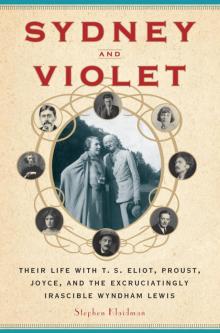- Home
- Stephen Klaidman
Sydney and Violet Page 28
Sydney and Violet Read online
Page 28
T. S. Eliot and his first wife, Vivienne, shown here with Sydney, were among the Schiffs’ closest friends from 1919 to 1924. After that, for various reasons, the relationship deteriorated and eventually petered out entirely. But when Sydney died and the war ended, Violet began seeing Eliot again, with his second wife, Valerie. (illustration credit 4)
The Schiffs regularly entertained friends at their summer house in Eastbourne on the southern coast of England. This group includes, besides the Schiffs, Wyndham Lewis; Vivienne Eliot; and the wife of Paolo Tosti, the composer of art songs and singing master to the royal family as well as to Violet and her sisters. (illustration credit 5)
Lady Ottoline Morrell’s country estate, Garsington, was a gathering place for the bright lights of Bloomsbury, including Leonard and Virginia Woolf, Clive and Vanessa Bell, John Maynard Keynes, Bertrand Russell, and Roger Fry. In this group, from left to right, are Lady Ottoline; Aldous Huxley’s wife, Maria Nys; Lytton Strachey; Duncan Grant; and Vanessa Bell. (illustration credit 6)
Lady Ottoline Morrell, the grande dame of Garsington, was both adored and brutally satirized by her guests. They never admitted that she was the target of their satire and never refused her hospitality. (illustration credit 7)
Aldous Huxley, who was a regular guest, took part in the bucolic activities encouraged on the estate, including pitching hay, for which he dressed appropriately. (illustration credit 8)
Croquet was a popular game at Garsington, which Wyndham played on one of his infrequent visits. Unlike Aldous Huxley, however, he lacked the proper attire. (illustration credit 9)
In 1922, the year Eliot’s The Wasteland was published and the year Proust completed In Search of Lost Time, Sylvia Beach, owner of the Paris bookstore Shakespeare & Co., published James Joyce’s Ulysses in an edition of one thousand. Adrienne Monnier, standing on the right, also owned a bookstore and translated Eliot’s The Love Song of J. Alfred Prufrock into French with Beach. (illustration credit 10)
Marcel Proust wrote large chunks of In Search of Lost Time in bed, mostly late at night and into the early morning hours while subsisting in the last years of his life on coffee, croissants, and ice-cold beer, which his driver, Odilon Albaret, would fetch from the Ritz, often after midnight.
Katherine Mansfield, the noted short-story writer who died at thirty-four of tuberculosis, mostly lived apart from her husband, the essayist and literary magazine editor John Middleton Murry. The arrangement seemed to suit them both, judging from the plethora of letters they wrote to each other. (illustration credit 11)
John Quinn, third from the left, was a New York lawyer who collected modernist art and literary manuscripts from the likes of James Joyce, Ezra Pound, and Ford Madox Ford, pictured with him, as well as Joseph Conrad. (illustration credit 12)
The Scottish poet, critic, and translator Edwin Muir and his wife, Willa, were close friends of the Schiffs during the mid- to late twenties. Edwin Muir ranked Sydney (Stephen Hudson) among the nine living writers whose work he believed would still be read decades later. The others included James Joyce, T. S. Eliot, D. H. Lawrence, and Virginia Woolf. (illustration credit 13)
Abinger Manor, in Surrey about an hour from London, was the house Sydney and Violet occupied during World War II. Part of the roof was blown off by a German rocket, which resulted in an injury to Violet’s back that left her partly crippled for the rest of her life.

 Sydney and Violet
Sydney and Violet